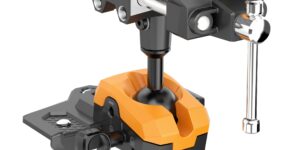HOW DOES WELDING AFFECT THE HAZ OF THE WELD'
Based upon the particular aluminum alloy type and its temper, the tensile strength of the HAZ can be significantly different from the tensile strength of the unaffected area of the welded component. However, the reduction in tensile strength of the HAZ under controlled conditions, particularly with the non-heat treatable alloys, can be somewhat predictable.
Posted: August 25, 2009
The question frequently arises as to how arc welding of both heat treatable and non-heat treatable alloys affects the strength of the heat-affected zone of the weld in aluminum-welded structures of different alloy types and designs.
To appreciate the affect of arc welding on the heat-affected zone of various aluminum alloys, evaluation of how these alloys obtain their strength and the potential for changes in strength after welding is necessary. There are seven series of aluminum alloys. Each one is designated by the primary alloying element used to produce that particular type of material.
Additionally, we can divide the seven aluminum alloy series into the heat treatable and non-heat treatable categories:
Series Primary Alloying Element
1xxx Aluminum ? 99.00 percent or Greater (Non-Heat Treatable)
2xxx Copper (Heat Treatable)
3xxx Manganese (Non-Heat Treatable)
4xxx Silicon (Non-Heat Treatable)
5xxx Magnesium (Non-Heat Treatable)
6xxx Magnesium and Silicon (Heat Treatable)
7xxx Zinc (Heat Treatable)
The addition of alloying elements to aluminum is the principal method used to produce a varietyof different materials that are useable in a wide assortment of applications. The principle reason for adding the primary alloying elements is to facilitate an improvement in the alloys physical and/or mechanical characteristics.
Typically, the addition of the primary alloying elements to aluminum is to provide improvement in work hardening and or precipitation hardening characteristics.
HOW ALUMINUM ALLOYS OBTAIN THEIR STRENGTH
Work Hardening
Work hardening is an important process used to increase the strength of materials that are unable to be strengthened by heat treatment. It can be applied to both heat treatable and non-heat treatable series material but it is used extensively to produce the strain-hardened tempers in the non-heat treatable aluminum alloys.
This process involves a change of shape brought about by the input of mechanical energy. As deformation proceeds, the material becomes stronger but harder and less ductile. The strain hardened temper of full-hard material -H18 for example is usually obtained with a cold work equal to about a 75 percent reduction in area. The -H16, -H14, and -H12 tempers are obtained with lesser amounts of cold working, and they represent three-quarter-hard, half-hard, and quarter-hard conditions, respectively. It is important to understand that the full affect of strain-hardening on the non-heat treatable alloy can be removed by heating the base material to its annealing temperature for a very short time period.
Precipitation Hardening
A second method of strengthening aluminum is precipitation heat treatment, which is preceded by solution heat-treating. Solution heat-treating is achieved by heating a material to a suitable temperature, holding at that temperature for a long enough time to allow constituents to enter into solid solution, and then cooling rapidly to hold the constituents in solution.
This process is usually followed by precipitation hardening or what is also termed artificial aging, which is achieved by re-heating the alloy to a lower temperature and holding it at this temperature for a specified time. The result of these heat treatments is to produce a metallurgical structure within the material that provides superior tensile strength.
If, during the artificial aging procedure, the material is held at a temperature for too long or the temperature used is too high, the material can become over-aged, resulting in a decrease in tensile strength. It is important to recognize that the precipitation hardening process is both time and temperature dependent. This method of strengthening is only used on the heat treatable aluminum alloys.
The Affect of Arc Welding on the Heat Affected Zone
In order to make a welded joint in an aluminum structure using the arc welding process, the base material must be melted. During the melting process, heat is transferred through conduction into the base material adjacent to the weld. Typically the completed weldment can be divided into three distinct areas: the weld metal, the heat affected zone adjacent to the weld and the base material beyond the HAZ which has been unaffected by the welding operation.
If arc welding on materials which have been strengthened by work hardening or precipitation hardening, because the HAZ will experience cycles of heating and cooling during the welding operation, its properties will change and may be extremely different than that of the original base alloy and the unaffected area of the base material (see Figure 1).
Non-Heat Treatable Alloys
What is important from a HAZ perspective is that the non-heat treatable aluminum alloys that are strengthened by strain hardening can be restored to a full soft, ductile condition by annealing. Annealing eliminates the strain hardening, as well as the microstructure that is developed as a result of cold working. The heating of the HAZ, which takes place during the arc welding operation, is sufficient to anneal the base material within the HAZ area.
For this reason the minimum tensile strength requirements for as welded non-heat treatable alloys, regardless of the original work hardened temper, is based on the annealed strength of the base alloy. Typical tensile strengths of non-heat treatable alloys in their tempered condition and as-welded are shown in Table 1.
Heat Treatable Alloys
In the case of the heat treatable alloys, the HAZ will normally not be fully annealed. The HAZ will experience a wide variety of temperatures as seen in Figure 1. The time at these temperatures and the rate of cooling back to room temperature will determine the amount of annealing that actually takes place in the HAZ.
This is not to suggest that there will not be a reduction in strength in the HAZ. The affect on the HAZ of a heat treatable alloy that is welded in the solution heat treated and artificially aged condition (T-6) is typically one of partially annealed and over-aged. This condition can be significantly affected by the heat input during the welding operation.
The general rule is, the higher the heat input, the lower the as welded strength. Typical tensile strengths of some of the heat treatable alloys in their temper condition and as welded are shown in table 2.
SUMMARY
Dependant on the particular aluminum alloy type and its temper, there can be significant difference between the tensile strength of the HAZ and the tensile strength of the unaffected area of the welded component. The reduction in tensile strength of the HAZ under controlled conditions, particularly with the non-heat treatable alloys, can be somewhat predictable.
The reduction in tensile strength of the HAZ in the heat treatable alloys is more susceptible to welding conditions and can be reduced below the required minimum requirement if excessive heating occurs during the welding operation.
– – – – – – – – – – – – – – – – – – – – – – – – – – – – – – – – – – – – – – – – –
Tony Anderson is the corporate technical training manger for ESAB North America, P.O. Box 100545, 411 South Ebenezer Road, Florence, SC 29501-0545, 843-679-5823, www.esab.com, tanderson@esab.com.









